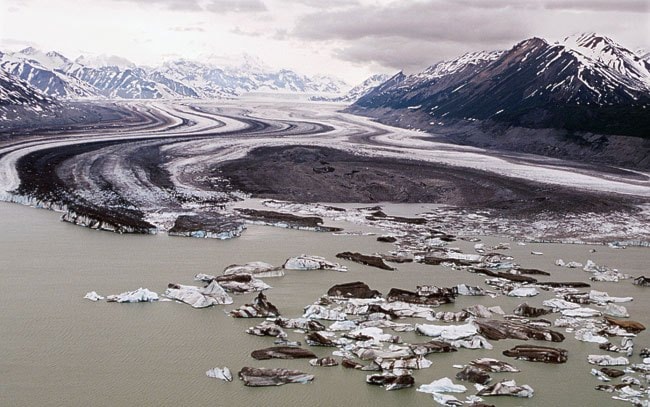The Yukon has some of the fastest-melting glaciers in the world, according to the first measurements of the territory’s impact on rising sea-levels.
But you might be surprised by the consequences. Yukon glaciers have raised global sea levels by one millimetre over the last 50 years.
Not impressed? You should be.
Though the number seems deceptively puny, consider this: if you took all the meltwater from the Yukon’s glaciers in the last 50 years and stretched it over the entire surface area of all the world’s oceans, you’ll have added one millimetre.
That’s a lot of melted ice.
In fact, it’s 406 cubic kilometres of ice down the drain in just half a century. Put another way, 22 per cent of the Yukon’s glaciers have vanished.
Tucked away in the remote St. Elias and Mackenzie Mountains, the Yukon’s glaciers have fallen off the scientific radar for years.
But now the first research ever on the Yukon’s impact on rising sea levels has been published by two geophysicists from the University of Alberta.
And we’re definitely punching above our weight.
“As a regional number, it’s quite a large one,” said Dr. Nick Barrand, a researcher at the University of Alberta who recently completed his study glaciers with colleague Dr. Martin Sharp. “And it’s a regional thinning rate that is greater than almost all other glacier and ice-cap regions.”
Outside of the Antarctic and Greenland ice sheets, a long list of smaller regions with glaciers and ice caps also contribute to the rise of sea levels currently underway.
Of those regions, only Alaskan and Patagonian glaciers are melting faster than the Yukon.
“It certainly will have local effects in terms of water supply to downstream regions,” said Barrand. “But the main focus of our work is the global picture.”
Barrand and Sharp didn’t do any fieldwork to figure out how fast the glaciers are shrinking.
They used an extensive archive of aerial photographs taken in 1957 and 1958 by the Canadian Land Survey. Covering every inch of the Yukon, they examined the photos of the territory’s glaciers and extrapolated their volume and size based on glacier formations around the world.
Then they compared the volumes with satellite photos from Landsat, a NASA-sponsored satellite that offers images of the Earth from space. Those pictures were taken in 2006 and 2008.
After comparing the two photo sets, the researchers had the first glimpse ever on how quickly the Yukon’s glaciers are disappearing.
“I’d say (Yukon glaciers) are very much understudied,” said Barrand. “One of the main reasons being that they’re so remote.”
“Almost no work at all has been done in the Yukon previously to this,” he said.
There has been some earlier work done by the University of Alaska, he said. But it only measured a few of the Yukon’s glaciers and grouped them within a larger Alaskan-based region.
There are around 10,000 square kilometres of glacial ice in the Yukon. Most of it is in the St. Elias Mountains, but glaciers also lie in the nooks and crannies of the Mackenzie Mountains.
“The Kluane glaciers receive a lot of snowfall,” said Barrand. “They’re by the coast, so the precipitation is high and they tend to be bigger generally.”
“The Mackenzie Mountains ones are smaller - they’re what we call cirque glaciers,” he said. “They sit within very deep, shaded mountain halls, so they don’t receive a great deal of precipitation.
“But because of their location, that’s how they’re able to remain there year-round.”
Barrand is originally from Leeds, England. He became fascinated by glaciers from courses he took as an undergrad in Newcastle, and pursued his interest with a doctorate degree from the University of Swansea.
“I’d visited them on holidays and I thought they were beautiful places,” he said. “I was interested in the way their melting affects global sea levels.”
“It’s a really important scientific and intellectual question.”
Now he will contribute to the global effort of determining what the impacts of melting sea ice will be.
The United Nations’ Intergovernmental Panel on Climate Change is currently gathering new data for its next meeting in Mexico next November. Authors are currently filing through new research and citing it in more overarching studies.
“Hopefully, it will be included in their next assessment,” said Barrand.
Contact James Munson at
jamesm@yukon-news.com.
